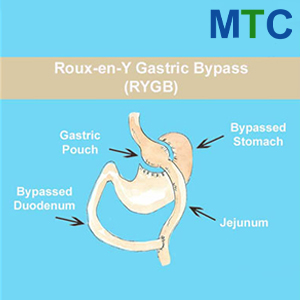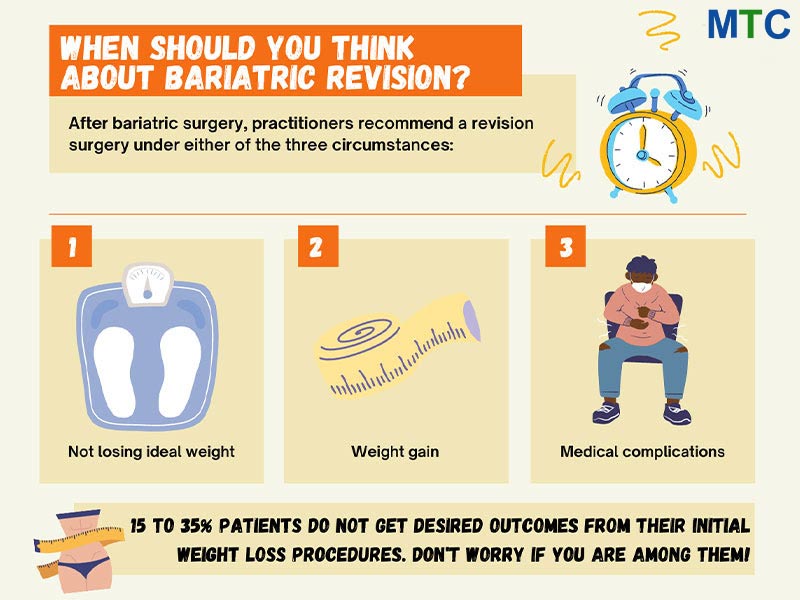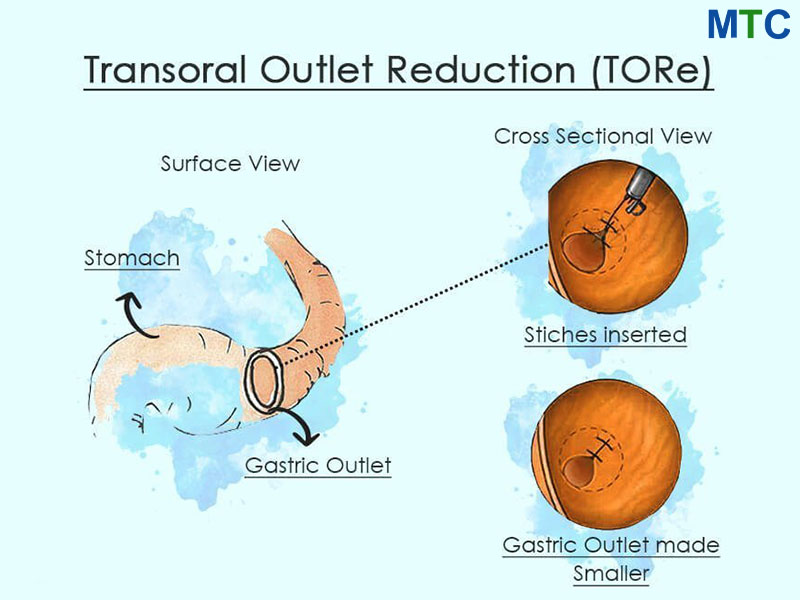Gastric Bypass to TORe
Bariatric surgery has become the go-to option for many people to treat obesity.
And gastric bypass is one of the most common and effective weight-loss surgery.[1]ASMBS
Bariatric Surgery Procedures
“It is one of the most common operations and is very effective in treating obesity and obesity related diseases. ”
View in Article
However, sometimes the gastric bypass procedure may fail, and one may need revision surgery.
That’s when gastric bypass to TORe revision surgery is done. Continue reading further to know the complete details.
Watch Our Partner Surgeon Dr. Perez, Talk About Revision Bariatric Surgery
What is Gastric Bypass Surgery?
Gastric bypass is one of the most common and effective weight-loss surgery.
This weight-loss surgery is:
- also known as Roux-en-Y Gastric Bypass (RYGB),
- as it forms a Y-shape after joining the parts of the intestine.
In this, a small pouch is created from the stomach & directly connected to the small intestine.[2]Medicine
Effectiveness of bariatric surgical procedures
“RYGB is a surgical procedure that constructs a small pouch from the proximal portion of the stomach, attaching directly to the small intestine. ”
View in Article

Gastric Bypass Surgery
RYGB is the most preferred weight-loss surgery due to the following reasons:
- Sustainable results
- Immediate weight-loss
- Improved quality of life
- Reduction of comorbidities
- Reduced pre-operative complications
Source: NCBI[3]NCBI
Revision of Roux-en-Y Gastric Bypass
“The main reasons for this supremacy of RYGBP in comparison to other bariatric techniques have always been the constant reduction in the associated peri-operative morbidity and mortality…”
View in Article
Why Do You Need Gastric Bypass Revision?
However, despite the high success rate, weight regain was seen in over 25% of the patients.[4]NCBI
Revision of Roux-en-Y Gastric Bypass for Inadequate Weight Loss or Weight Regain
“Inadequate weight loss or weight regain after Roux-en-Y gastric bypass (RYGBP) occurs in more than a quarter of patients for various reasons.”
View in Article
To tackle this situation, gastric bypass revision surgery is recommended.

Why Do You Need Bariatric Revision?
The most common reasons for gastric bypass revision are:
- Significant weight regains after weight loss surgery.
- Not enough loss of excess body weight after bariatric surgery.
- Enlargement of gastro-jejunal stoma size, leading to reduced satiety.
Source: Mayo Clinic[5]Mayo Clinic
The use of transoral outlet reduction endoscopy
“One of the most common factors contributing to weight regain is the enlargement of gastrojejunal stoma size, which reduces satiety and allows patients to increase the volume of food consumed in one meal. ”
View in Article
That’s when TORe comes into the picture. Scroll down to the next section to learn about it.
All About TORe: Cost & Procedure
Overview
This is a minimally invasive endoscopic surgery:
- that reduces the size of the gastro-jejunal stoma,
- to achieve weight loss through mechanical restriction.
Source: PubMed[6]PubMed
Efficacy of transoral outlet reduction
“TORe is a minimally invasive endoscopic surgery that reduces the size of the GJA to achieve weight loss through mechanical restriction.”
View in Article
Cost
However, it will cost you only $6,595 in Tijuana, Mexico.
This is how you can end up saving ~50-70% with MTC!
| Procedure | US | AUS | Mexico |
|---|---|---|---|
| TORe | $15,000 | $20,000 | $6,595 |
*These are estimated prices. Contact us for latest prices & get your FREE quote today!
Procedure
Transoral outlet reduction is done while you are under anesthesia.
It lasts about 1-2 hours, and most patients go home the same day.
To perform transoral outlet reduction:
- The surgeon inserts an endoscope into your mouth and guides it into the stomach pouch to examine the inside of your stomach.
- Heat treatment is applied to the edge of the gastric outlet to help it narrow & close.
- A suturing device is placed on the end of the endoscope to tighten the gastric outlet.
- The gastric stoma diameter is reduced by ~80%, and the endoscope is removed.
- Decreasing the opening’s size will allow you to feel full and help you lose weight.
Source: Link Springer[7]Link Springer
Long-term Outcomes of Transoral Outlet Reduction (TORe)
“All TORe procedures were performed under general anesthesia using the full-thickness suturing system Apollo OverStitch (Apollo Endosurgery, Austin, TX, USA), and a double-channel therapeutic endoscope… ”
View in Article

Illustration of TORe Procedure
Best Surgeon for Gastric Bypass Revision Surgery
Dr. Hector Perez is a leading bariatric surgeon practicing in Tijuana & Cancun, Mexico.
He has been performing weight loss surgeries since 2006.

Experience: 15+ years
Specializations:
- Weight-loss Surgery
- Revision Bariatric Surgery
Education:
- Medical internship from Jackson Memorial Hospital
- General surgery with honors from Mexican National University
He is nationally-accredited and also board-certified by:
- Mexican Council of General Surgery,
- Mexican College of Obesity Surgery and Metabolic Diseases.
To know more about Dr. Perez, you can read his resume here and have a look at the video below.
Dr. Hector Perez: Our Bariatric Surgeon in Mexico
Gastric Bypass to TORe: Success & Risks
Now, let’s have a look at the TORe procedure’s success and complications:
TORe Procedure’s Success:
- Minimially invasive surgery.
- Effective, safe with long-term results (up to 5 years).
- Low-risk of serious complications and zero mortality rate.
Source: MDPI[8]MDPI
Transoral Outlet Reduction (TORe)
“The TORe technique has now repeatedly demonstrated its efficacy, safety and favorable long term results for up to 5 years in the management of weight regain after RYGB…. ”
View in Article
TORe Procedure’s Risks:
- Minor intra-procedural complications.
- Mild bleeding from marginal ulceration in the track.
Source: MDPI[9]MDPI
Transoral Outlet Reduction (TORe)
“On the other hand, the TORe procedure has demonstrated a high degree of safety, with only minor intraprocedural adverse effects (AE) such as superficial lacerations of the esophageal mucosa due to the use of the overtube….. ”
View in Article
FAQs
Does the TORe procedure work?
Yes, the TORe procedure works effectively and helps you manage weight regain after RYGB.
It is considered safe and a long-term solution to tackle your weight regain.
What can you eat after a TORe procedure?
After the surgery, you will be discharged on a liquid diet for the initial days.
You will gradually shift from liquid diet to solid food after few days, as per the diet plan provided to you.
What are the benefits of TORe?
TORe is a minimally invasive surgery that:
- reduces the opening’s size between your stomach pouch & intestine,
- which further helps you feel fuller and achieve weight loss.
How much weight can you lose after the TORe procedure?
It’s seen that the patients who undergo TORe procedure are expected to lose 8-10% of their weight and maintain it for 5 years.[10]GIE Journal
Five-year outcomes of transoral outlet reduction
“In this study, patients who underwent TORe were able to maintain significant weight loss of 8.6% of their initial weight at 5 years. ”
View in Article
Conclusion
Unhappy with your prior gastric bypass or experiencing weight regain?
Choose gastric bypass to TORe surgery and lose that extra weight!
TORe has been an effective and safe way of managing weight regain post RYGB.
So, what are you waiting for? Start your journey with MTC today.
References
1. ASMBS- Bariatric Surgery Procedures
2. Medicine- Effectiveness of bariatric surgical procedures
3. NCBI- Revision of Roux-en-Y Gastric Bypass
4. Mayo Clinic- The use of transoral outlet reduction endoscopy
5. PubMed- Efficacy of transoral outlet reduction
6. Link Springer- Long-term Outcomes of Transoral Outlet Reduction (TORe)
7. MDPI- Transoral Outlet Reduction (TORe)
8. GIE Journal- Five-year outcomes of transoral outlet reduction








